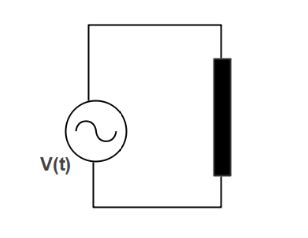
Answer
361.2k+ views
Hint: In circuits with essentially capacitive loads, current leads to the voltage. Current must first move to the two plates of the capacitor, where a charge is collected. Only after charge stores at the plates of a capacitor is a voltage difference set.
Complete step-by-step solution:
Given: $V(t) = (80V) sin wt$
$I(t) = (1.6A) sin\left( wt + \dfrac{\pi}{4} \right)$
As we can see, current leads to voltage.
This circuit is capacitive.
The black box contains at least one resistor and capacitor.
$\lt P_{av} \gt = \dfrac{V_{m} I_{m}}{2}$
We have, $V_{m} = 80V$
$I_{m} = 1.6A$
Put all the given values,
$\lt P_{av} \gt = \dfrac{80 \times 1.6}{2} cos\dfrac{\pi}{4}$
$\implies \lt P_{av} \gt = 45.25 W$
When capacitors are combined across a direct current DC voltage, their plates charge to the voltage value crossed; the capacitor is equal to that of the externally connected voltage. The capacitor will operate this charge regularly, acting as a transient storage device as long as the implemented voltage is kept.
Note:The movement of electrons onto the plates of a capacitor is directly proportional to the rate of change of the voltage across those plates. Then, we can observe that capacitors in AC circuits like to move current when the voltage across its plates constantly changes concerning time, such as in AC signals, but it does not like to move current when the implemented voltage is of a constant value DC signals.
Complete step-by-step solution:
Given: $V(t) = (80V) sin wt$
$I(t) = (1.6A) sin\left( wt + \dfrac{\pi}{4} \right)$
As we can see, current leads to voltage.
This circuit is capacitive.
The black box contains at least one resistor and capacitor.
$\lt P_{av} \gt = \dfrac{V_{m} I_{m}}{2}$
We have, $V_{m} = 80V$
$I_{m} = 1.6A$
Put all the given values,
$\lt P_{av} \gt = \dfrac{80 \times 1.6}{2} cos\dfrac{\pi}{4}$
$\implies \lt P_{av} \gt = 45.25 W$
When capacitors are combined across a direct current DC voltage, their plates charge to the voltage value crossed; the capacitor is equal to that of the externally connected voltage. The capacitor will operate this charge regularly, acting as a transient storage device as long as the implemented voltage is kept.
Note:The movement of electrons onto the plates of a capacitor is directly proportional to the rate of change of the voltage across those plates. Then, we can observe that capacitors in AC circuits like to move current when the voltage across its plates constantly changes concerning time, such as in AC signals, but it does not like to move current when the implemented voltage is of a constant value DC signals.
Recently Updated Pages
How many sigma and pi bonds are present in HCequiv class 11 chemistry CBSE

Mark and label the given geoinformation on the outline class 11 social science CBSE

When people say No pun intended what does that mea class 8 english CBSE

Name the states which share their boundary with Indias class 9 social science CBSE

Give an account of the Northern Plains of India class 9 social science CBSE

Change the following sentences into negative and interrogative class 10 english CBSE

Trending doubts
Difference Between Plant Cell and Animal Cell

Fill the blanks with the suitable prepositions 1 The class 9 english CBSE

Difference between Prokaryotic cell and Eukaryotic class 11 biology CBSE

Differentiate between homogeneous and heterogeneous class 12 chemistry CBSE

Write a letter to the principal requesting him to grant class 10 english CBSE

Give 10 examples for herbs , shrubs , climbers , creepers

Write the differences between monocot plants and dicot class 11 biology CBSE

Change the following sentences into negative and interrogative class 10 english CBSE

Why is there a time difference of about 5 hours between class 10 social science CBSE




